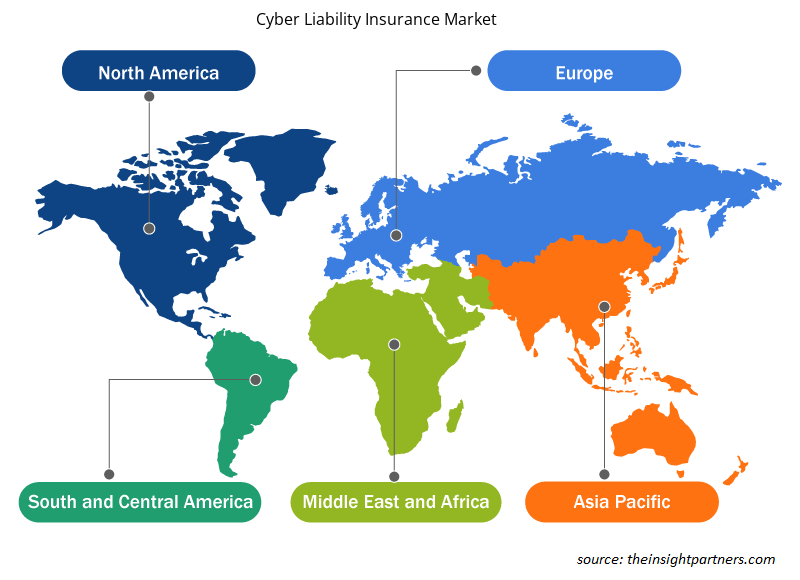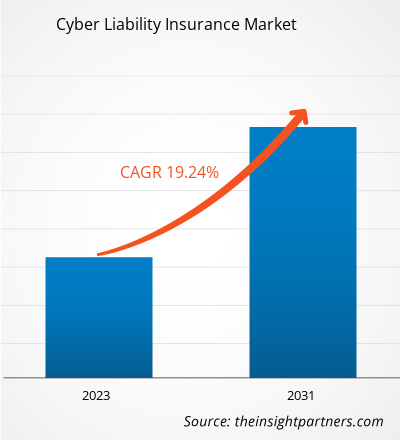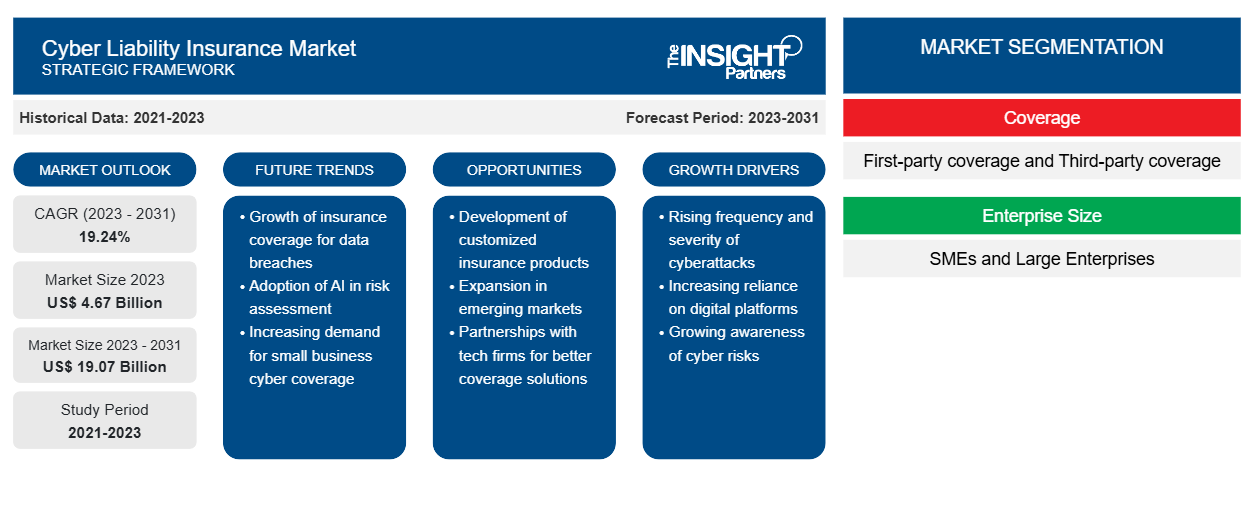من المتوقع أن ينمو سوق التأمين على المسؤولية السيبرانية من 4.67 مليار دولار أمريكي في عام 2023 إلى 19.07 مليار دولار أمريكي بحلول عام 2031؛ ومن المتوقع أن يتوسع بمعدل نمو سنوي مركب قدره 19.24٪ من عام 2023 إلى عام 2031. هناك عوامل مثل زيادة التهديدات السيبرانية والامتثال التنظيمي تدفع نمو سوق التأمين على المسؤولية السيبرانية.
تحليل سوق تأمين المسؤولية السيبرانية
يتطور سوق التأمين على المسؤولية السيبرانية باستمرار لمواجهة التحديات المتزايدة التي تفرضها التهديدات السيبرانية. ومع انتشار التهديدات السيبرانية وتطورها، هناك طلب متزايد على تغطية التأمين على المسؤولية السيبرانية. تدرك المنظمات في جميع الصناعات الحاجة إلى حماية نفسها من الخسائر المالية المحتملة والأضرار التي تلحق بسمعتها بسبب الهجمات السيبرانية. يقدم التطور السريع للتكنولوجيا، مثل الذكاء الاصطناعي وإنترنت الأشياء والتكنولوجيا التشغيلية، فرصًا ومخاطر في نمو سوق التأمين على المسؤولية السيبرانية. في حين تقدم هذه التقنيات فوائد كبيرة، فإنها تخلق أيضًا أسطح هجوم ونقاط ضعف جديدة. لدى شركات التأمين الفرصة لتطوير حلول تغطية مبتكرة لمعالجة هذه المخاطر الناشئة.
نظرة عامة على سوق التأمين على السيارات
- يعد تأمين المسؤولية السيبرانية أحد أنواع التغطية التأمينية التي تساعد في حماية الشركات من الخسائر المالية والمسؤوليات الناتجة عن الحوادث السيبرانية وانتهاكات البيانات. وهو يوفر تغطية للنفقات المتعلقة بالتحقيق في الهجمات السيبرانية ومعالجتها، والمسؤوليات القانونية، وانقطاع الأعمال، وفقدان الإيرادات، واستعادة البيانات، من بين التكاليف الأخرى المرتبطة بالحوادث السيبرانية.
- تركز شركات التأمين على توفير إدارة شاملة للمخاطر وخدمات ما قبل الاختراق لحاملي وثائق التأمين الخاصة بهم. تساعد هذه الخدمات المؤسسات على تقييم مخاطرها السيبرانية وتنفيذ استراتيجيات قوية لإدارة المخاطر وتعزيز مرونتها السيبرانية. على سبيل المثال، قدمت شركة Spring Insure عرضًا تجاريًا إلكترونيًا مصممًا خصيصًا للشركات الصغيرة والمتوسطة الحجم، والذي يتضمن الوصول إلى إدارة المخاطر وخدمات ما قبل الاختراق.
- لقد شهد السوق تغيرات في أقساط التأمين والتغطية. يختار عملاء التأمين التغطية السيبرانية بمعدل متزايد، مما يؤدي إلى تعديلات في الأسعار والتوافر. تعمل شركات التأمين على إيجاد توازن بين تلبية الطلب على التغطية والحفاظ على الربحية. كما تعمل على تكييف عروض التغطية الخاصة بها لمعالجة المخاطر السيبرانية المتطورة وعدم اليقين.
قم بتخصيص هذا التقرير ليناسب متطلباتك
ستحصل على تخصيص لأي تقرير - مجانًا - بما في ذلك أجزاء من هذا التقرير، أو تحليل على مستوى الدولة، وحزمة بيانات Excel، بالإضافة إلى الاستفادة من العروض والخصومات الرائعة للشركات الناشئة والجامعات
-
احصل على أهم اتجاهات السوق الرئيسية لهذا التقرير.ستتضمن هذه العينة المجانية تحليلاً للبيانات، بدءًا من اتجاهات السوق وحتى التقديرات والتوقعات.
محركات وفرص سوق التأمين على المسؤولية السيبرانية
تزايد التهديدات السيبرانية يحرك سوق التأمين على المسؤولية السيبرانية
- إن العدد المتزايد من التهديدات الإلكترونية وتعقيداتها، مثل خروقات البيانات وهجمات برامج الفدية وحوادث القرصنة، يدفع الطلب على تأمين المسؤولية الإلكترونية في السوق. وتدرك المنظمات الحاجة إلى حماية نفسها من الخسائر المالية والأضرار التي تلحق بسمعتها بسبب الحوادث الإلكترونية.
- أصبحت التهديدات السيبرانية أكثر انتشارًا وتقدمًا، مما يشكل مخاطر كبيرة على الشركات. يمكن أن تؤدي خروقات البيانات، حيث يتم المساس بالمعلومات الحساسة، إلى خسائر مالية ومسؤوليات قانونية وإلحاق الضرر بسمعة الشركة. يمكن أن تؤدي هجمات برامج الفدية، حيث يقوم المتسللون بتشفير البيانات ويطلبون فدية مقابل إطلاقها، إلى تعطيل العمليات التجارية وتؤدي إلى خسائر مالية. يمكن أن تؤدي حوادث القرصنة إلى تعريض الأنظمة والشبكات للخطر، مما يسمح بالوصول غير المصرح به إلى البيانات الحساسة.
تقرير تحليل تجزئة سوق التأمين على المسؤولية السيبرانية
- بناءً على التغطية، يتم تقسيم السوق إلى تغطيات الطرف الأول وتغطيات الطرف الثالث. ومن المتوقع أن يحظى قطاع التغطية للطرف الأول بحصة كبيرة في سوق تأمين المسؤولية السيبرانية في عام 2023.
- يشير قطاع تغطية الطرف الأول إلى التغطية التي توفرها سياسات التأمين على المسؤولية السيبرانية لخسائر ونفقات الشركة المؤمنة الناتجة عن حادث سيبراني. تم تصميم هذه التغطية لتقليل التأثير المالي على الشركة التي اشترت التأمين. تساعد هذه التغطية في تغطية النفقات التي تتكبدها الشركة المؤمنة في الاستجابة لخرق البيانات. قد تشمل تكاليف مثل التحقيقات الجنائية لتحديد سبب ومدى الخرق، وإخطار الأفراد المتضررين، وخدمات مراقبة الائتمان، وجهود العلاقات العامة، والنفقات القانونية.
تحليل إقليمي لسوق التأمين على المسؤولية السيبرانية
ينقسم نطاق تقرير سوق التأمين على المسؤولية السيبرانية بشكل أساسي إلى خمس مناطق - أمريكا الشمالية وأوروبا وآسيا والمحيط الهادئ والشرق الأوسط وأفريقيا وأمريكا الجنوبية. تشهد أمريكا الشمالية نموًا سريعًا ومن المتوقع أن تحتفظ بحصة سوقية كبيرة للتأمين على المسؤولية السيبرانية. تهيمن منطقة أمريكا الشمالية، وخاصة الولايات المتحدة، على سوق أمريكا الشمالية. تستفيد أمريكا الشمالية من البنية التحتية التكنولوجية المتقدمة ومستوى عالٍ من تبني التكنولوجيا السيبرانية. وهذا يخلق حاجة أكبر للتأمين على المسؤولية السيبرانية حيث تسعى المنظمات إلى حماية نفسها من الخسائر المالية والأضرار السمعية المتأثرة بالحوادث السيبرانية. تعرض الولايات المتحدة، على وجه الخصوص، فرصًا كبيرة لمقدمي حلول التأمين على الأمن السيبراني بسبب لوائحها الصارمة ووجود مجموعة متنوعة من الصناعات. تخلف الهجمات السيبرانية تأثيرًا ماليًا كبيرًا على الشركات من جميع الأحجام، بما في ذلك قطاعات البنية التحتية الحيوية. ونتيجة لذلك، تدرك المنظمات في أمريكا الشمالية بشكل متزايد أهمية التأمين على المسؤولية السيبرانية.
رؤى إقليمية حول سوق التأمين على المسؤولية السيبرانية
لقد قام المحللون في Insight Partners بشرح الاتجاهات والعوامل الإقليمية المؤثرة على سوق التأمين على المسؤولية السيبرانية طوال فترة التنبؤ بشكل شامل. يناقش هذا القسم أيضًا قطاعات سوق التأمين على المسؤولية السيبرانية والجغرافيا في جميع أنحاء أمريكا الشمالية وأوروبا ومنطقة آسيا والمحيط الهادئ والشرق الأوسط وأفريقيا وأمريكا الجنوبية والوسطى.

- احصل على البيانات الإقليمية المحددة لسوق تأمين المسؤولية السيبرانية
نطاق تقرير سوق التأمين على المسؤولية السيبرانية
| سمة التقرير | تفاصيل |
|---|---|
| حجم السوق في عام 2023 | 4.67 مليار دولار أمريكي |
| حجم السوق بحلول عام 2031 | 19.07 مليار دولار أمريكي |
| معدل النمو السنوي المركب العالمي (2023 - 2031) | 19.24% |
| البيانات التاريخية | 2021-2023 |
| فترة التنبؤ | 2023-2031 |
| القطاعات المغطاة |
حسب التغطية
|
| المناطق والدول المغطاة |
أمريكا الشمالية
|
| قادة السوق وملفات تعريف الشركات الرئيسية |
|
كثافة اللاعبين في سوق تأمين المسؤولية السيبرانية: فهم تأثيرها على ديناميكيات الأعمال
يشهد سوق تأمين المسؤولية السيبرانية نموًا سريعًا، مدفوعًا بالطلب المتزايد من المستخدم النهائي بسبب عوامل مثل تفضيلات المستهلك المتطورة والتقدم التكنولوجي والوعي المتزايد بفوائد المنتج. ومع ارتفاع الطلب، تعمل الشركات على توسيع عروضها والابتكار لتلبية احتياجات المستهلكين والاستفادة من الاتجاهات الناشئة، مما يؤدي إلى زيادة نمو السوق.
تشير كثافة اللاعبين في السوق إلى توزيع الشركات أو المؤسسات العاملة في سوق أو صناعة معينة. وهي تشير إلى عدد المنافسين (اللاعبين في السوق) الموجودين في مساحة سوق معينة نسبة إلى حجمها أو قيمتها السوقية الإجمالية.
الشركات الرئيسية العاملة في سوق تأمين المسؤولية السيبرانية هي:
- ايه اي جي
- ام تراست المالية
- شركة أكسا
- تشوب
- شركة جيكو
إخلاء المسؤولية : الشركات المذكورة أعلاه ليست مرتبة بأي ترتيب معين.

- احصل على نظرة عامة على أهم اللاعبين الرئيسيين في سوق تأمين المسؤولية السيبرانية
"تحليل سوق تأمين المسؤولية السيبرانية"تم إجراء ذلك بناءً على التغطية ونوع السيارة والتطبيق والجغرافيا. من حيث التغطية، يتم تقسيم السوق إلى تغطية الطرف الأول وتغطية الطرف الثالث. بناءً على حجم المؤسسة، يتم تقسيم السوق إلى الشركات الصغيرة والمتوسطة الحجم والمؤسسات الكبيرة. بناءً على المستخدم النهائي، يتم تقسيم السوق إلى BFSI وIT وITES وتجارة التجزئة والتجارة الإلكترونية والسفر والسياحة والضيافة وغيرها. بناءً على الجغرافيا، يتم تقسيم السوق إلى أمريكا الشمالية وأوروبا ومنطقة آسيا والمحيط الهادئ والشرق الأوسط وأفريقيا وأمريكا الجنوبية.
أخبار سوق التأمين على المسؤولية السيبرانية والتطورات الأخيرة
تتبنى الشركات استراتيجيات غير عضوية وعضوية مثل عمليات الدمج والاستحواذ في السوق. يتم تقدير توقعات سوق التأمين على المسؤولية السيبرانية بناءً على نتائج بحثية ثانوية وأولية مختلفة، مثل منشورات الشركة الرئيسية وبيانات الجمعيات وقواعد البيانات. فيما يلي بعض التطورات الرئيسية الأخيرة في السوق:
- في فبراير 2024، أعلنت شركة RT Specialty، قسم التوزيع بالجملة لشركة Ryan Specialty، وهي شركة تأمين متخصصة دولية رائدة، عن إضافة Cyber Liability إلى منصتها الرقمية الخاصة، RT Connector.
[المصدر: Ryan Specialty, LLC، موقع الشركة على الويب]
- في يوليو 2023، قدمت شركة Risk Strategies، وهي شركة وساطة تأمين وإدارة مخاطر، منصتها لإدارة المخاطر السيبرانية (RMP)، وهي خدمة جديدة تركز على إدارة المخاطر السيبرانية. تتجاوز هذه المنصة عمليات مسح الثغرات الخارجية التقليدية من خلال تزويد العملاء بتوصيات عملية لتعزيز دفاعاتهم السيبرانية.
[المصدر: استراتيجيات المخاطر، موقع الشركة على الويب]
تقرير سوق التأمين على المسؤولية السيبرانية - التغطية والنتائج
يقدم تقرير السوق "حجم سوق تأمين المسؤولية السيبرانية والتوقعات (2021-2031)" تحليلاً مفصلاً للسوق يغطي المجالات التالية: -
- حجم السوق والتوقعات على المستوى العالمي والإقليمي والوطني لجميع قطاعات السوق الرئيسية المشمولة بالنطاق.
- ديناميكيات السوق مثل المحركات والقيود والفرص الرئيسية.
- الاتجاهات المستقبلية الرئيسية.
- تحليل مفصل لـ PEST و SWOT
- تحليل السوق العالمي والإقليمي يغطي اتجاهات السوق الرئيسية، واللاعبين الرئيسيين، واللوائح، والتطورات الأخيرة في السوق.
- تحليل المشهد الصناعي والمنافسة الذي يغطي تركيز السوق، وتحليل الخريطة الحرارية، واللاعبين الرئيسيين، والتطورات الأخيرة.
- ملفات تعريفية مفصلة للشركة.
- التحليل التاريخي (سنتان)، سنة الأساس، التوقعات (7 سنوات) مع معدل النمو السنوي المركب
- تحليل PEST و SWOT
- حجم السوق والقيمة / الحجم - عالمي، إقليمي، بلد
- الصناعة والمنافسة
- مجموعة بيانات إكسل
التقارير الحديثة
تقارير ذات صلة
شهادات العملاء
سبب الشراء
- اتخاذ قرارات مدروسة
- فهم ديناميكيات السوق
- تحليل المنافسة
- رؤى العملاء
- توقعات السوق
- تخفيف المخاطر
- التخطيط الاستراتيجي
- مبررات الاستثمار
- تحديد الأسواق الناشئة
- تحسين استراتيجيات التسويق
- تعزيز الكفاءة التشغيلية
- مواكبة التوجهات التنظيمية























 احصل على عينة مجانية ل - سوق تأمين المسؤولية السيبرانية
احصل على عينة مجانية ل - سوق تأمين المسؤولية السيبرانية